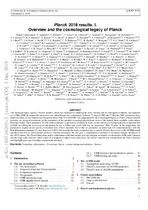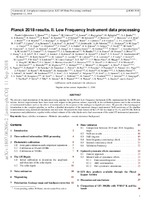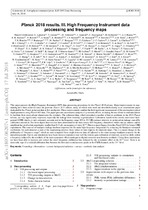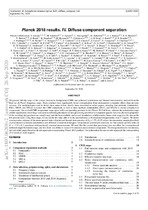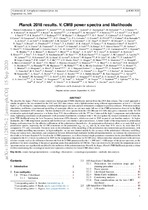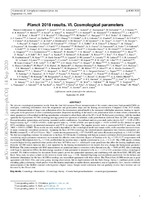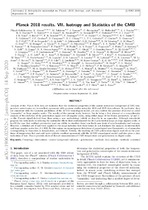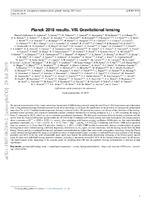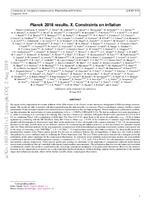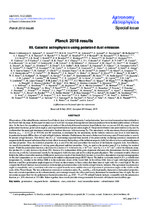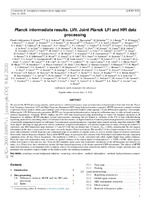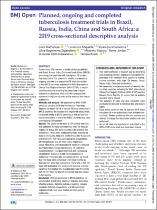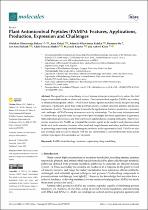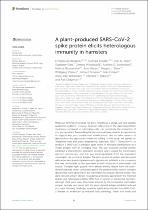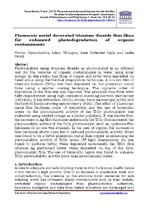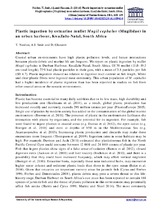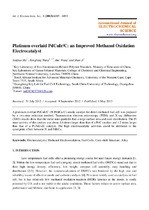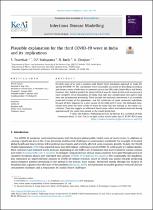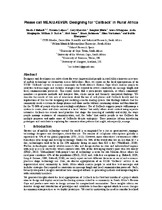Browsing Faculty of Natural Sciences by Title
Now showing items 1798-1817 of 2571
-
Planck 2018 results. XI. Polarized dust foregrounds
(EDP Sciences, 2020)The study of polarized dust emission has become entwined with the analysis of the cosmic microwave background (CMB) polarization in the quest for the curl-like B-mode polarization from primordial gravitational waves and ... -
Planck 2018 results: I. Overview and the cosmological legacy of Planck
(EDP Sciences, 2020)The European Space Agency’s Planck satellite, which was dedicated to studying the early Universe and its subsequent evolution, was launched on 14 May 2009. It scanned the microwave and submillimetre sky continuously between ... -
Planck 2018 results: II. low frequency Instrument data processing
(EDP Sciences, 2020)We present a final description of the data-processing pipeline for the Planck Low Frequency Instrument (LFI), implemented for the 2018 data release. Several improvements have been made with respect to the previous release, ... -
Planck 2018 results: III. High frequency instrument data processing and frequency maps
(EDP Sciences, 2020)This paper presents the High Frequency Instrument (HFI) data processing procedures for the Planck 2018 release. Major improvements in mapmaking have been achieved since the previous Planck 2015 release, many of which were ... -
Planck 2018 results: IV. Diffuse component separation
(EDP Sciences, 2020)We present full-sky maps of the cosmic microwave background (CMB) and polarized synchrotron and thermal dust emission, derived from the third set of Planck frequency maps. These products have significantly lower contamination ... -
Planck 2018 results: V. CMB power spectra and likelihoods
(EDP Sciences, 2020)We describe the legacy Planck cosmic microwave background (CMB) likelihoods derived from the 2018 data release. The overall approach is similar in spirit to the one retained for the 2013 and 2015 data release, with a hybrid ... -
Planck 2018 results: VI. Cosmological parameters
(EDP Sciences, 2020)We present cosmological parameter results from the final full-mission Planck measurements of the cosmic microwave background (CMB) anisotropies, combining information from the temperature and polarization maps and the ... -
Planck 2018 results: VII. Isotropy and statistics of the CMB
(EDP Sciences, 2020)Analysis of the Planck 2018 data set indicates that the statistical properties of the cosmic microwave background (CMB) temperature anisotropies are in excellent agreement with previous studies using the 2013 and 2015 data ... -
Planck 2018 results: VIII. Gravitational lensing
(EDP Sciences, 2020)We present measurements of the cosmic microwave background (CMB) lensing potential using the final Planck 2018 temperature and polarization data. Using polarization maps filtered to account for the noise anisotropy, we ... -
Planck 2018 results: X. Constraints on inflation
(EDP Sciences, 2020)We report on the implications for cosmic inflation of the 2018 release of the Planck cosmic microwave background (CMB) anisotropy measurements. The results are fully consistent with those reported using the data from the ... -
Planck 2018 results: XII. Galactic astrophysics using polarized dust emission
(EDP Sciences, 2020)Observations of the submillimetre emission from Galactic dust, in both total intensity I and polarization, have received tremendous interest thanks to the Planck full-sky maps. In this paper we make use of such full-sky ... -
Planck intermediate results. LVII. Joint Planck LFI and HFI data processing
(ESO, 2020)We present the NPIPE processing pipeline, which produces calibrated frequency maps in temperature and polarization from data from the Planck Low Frequency Instrument (LFI) and High Frequency Instrument (HFI) using ... -
Planned, ongoing and completed tuberculosis treatment trials in Brazil, Russia, India, China and South Africa: A 2019 cross-sectional descriptive analysis
(BMJ Publishing Group, 2022)Tuberculosis (TB) remains a deadly challenge globally and Brazil, Russia, India, China and South Africa (BRICS) are among the countries with the highest TB burden. The objective of this study is to identify and ... -
Plant antimicrobial peptides (pamps): Features, applications, production, expression and challenges
(MDPI, 2022)The quest for an extraordinary array of defense strategies is imperative to reduce the challenges of microbial attacks on plants and animals. Plant antimicrobial peptides (PAMPs) are a subset of antimicrobial peptides ... -
A plant-produced SARS-CoV-2 spike protein elicits heterologous immunity in hamsters
(Frontiers Media, 2023)Molecular farming of vaccines has been heralded as a cheap, safe and scalable production platform. In reality, however, differences in the plant biosynthetic machinery, compared to mammalian cells, can complicate the ... -
Plasmonic metal decorated titanium dioxide thin films for enhanced photodegradation of organic contaminants
(Elsevier, 2017)Photocatalysis using titanium dioxide as photocatalyst is an efficient way for the removal of organic contaminants in water using solar energy. In this study, thin films of copper and silver were deposited on fused ... -
Plastic ingestion by estuarine mullet Mugil cephalus (Mugilidae) in an urban harbour, KwaZulu-Natal, South Africa
(National Inquiry Services Centre (NISC), 2016)Coastal urban environments have high plastic pollution levels, and hence interactions between plastic debris and marine life are frequent. We report on plastic ingestion by mullet Mugil cephalus in Durban Harbour, ... -
Platinum overlaid PdCulr/C: an Improved Methanol Oxidation Elextrocatalyst
(ESG, 2013)A platinum overlaid PdCuIr/C (Pt-PdIrCu/C) anodic catalyst for direct methanol fuel cell was prepared by a two-step reduction method. Transmission electron microscopy (TEM) and X-ray diffraction (XRD) results show that the ... -
Plausible explanation for the third COVID-19 wave in India and its implications
(KeAi Communications, 2023)Recently some of us used a random-walk Monte Carlo simulation approach to study the spread of COVID-19. The calculations were reasonably successful in describing secondary and tertiary waves of infection, in countries such ... -
Please call ME.N.U.4EVER: designing for “Callback” in rural Africa
(Product & Systems Internationalisation, Inc, 2011)Designers and developers are naïve about the ways impoverished people in rural Africa innovate new uses of mobile technology to circumvent access difficulties. Here, we report on the local appropriation of an USSD ‘Callback’ ...


